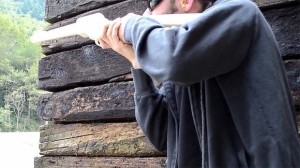 The competition for most successful 3D-printed firearm has moved to Canada, where a man known only as “Matthew” claims to have designed a 3D-printed rifle that withstood 14 shots. In a YouTube video published last Friday, the rifle is fired successfully three times before a text screen claims it developed a crack in the barrel after firing 14 total shots.
The competition for most successful 3D-printed firearm has moved to Canada, where a man known only as “Matthew” claims to have designed a 3D-printed rifle that withstood 14 shots. In a YouTube video published last Friday, the rifle is fired successfully three times before a text screen claims it developed a crack in the barrel after firing 14 total shots.
The recent development is an upgrade to an earlier design called “The Grizzly” after a Canadian-built tank used prominently in World War II. The finished product of that design was first fired in June, but suffered damage after just one shot, according to the International Business Times.
The new design, called Grizzly 2.0, is the most notable development for 3D-printed firearms since the U.S. State Department forced Texas-based Defense Distributed to remove design files for its 3D-printed handgun, The Liberator, just days after it fired its first shots in May. In a letter to Defense Distributed, the State Department’s Office of Defense Trade Compliance said the files would need to be reviewed for violations of international weapons regulations.
The files were available on Defense Distributed’s website, Defcad.org, for just two days, and were downloaded more than 100,000 times.
“I still think we win in the end,” Defense Distributed founder Cody Wilson told BetaBeat after the ruling. “Because the files are all over the Internet, the Pirate Bay has it – to think this can be stopped in any meaningful way is to misunderstand what the future of distributive technologies is about.”
Lawmakers, particularly in New York, have since scrambled to regulate 3D-printed guns. In June, New York City Council Member Lewis Fidler introduced a bill that would make it illegal for anyone but gunsmiths to build gun parts using a 3D printer. Under that proposal, gunsmiths who legally built a 3D-printed gun would have 72 hours to register it with police.
In late May, New York State Assemblywoman Linda Rosenthal introduced a bill to make it a felony offense to manufacture, use, or sell guns or gun parts, such as magazines, that were built with a 3D printer. Defense Distributed got its start using a 3D printer to build operational magazines for assault rifles.
Meanwhile, Sen. Charles Schumer and Congressman Steve Israel, both also from New York, have urged Congress to renew the Undetectable Firearms Act of 1988, which was first passed as a precaution against the creation of plastic guns that could get past metal detectors. The law expires this December.





